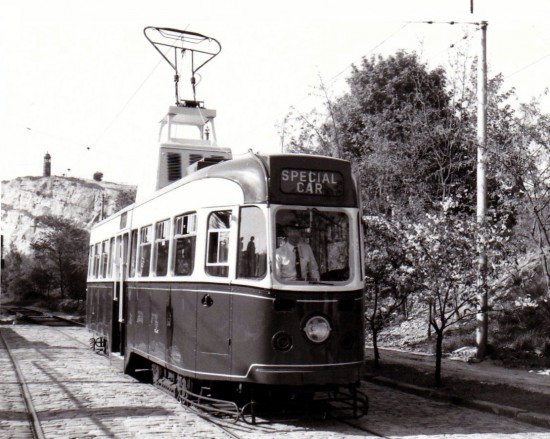A very popular tram – part of the static collection at Crich nowadays of course – with enthusiasts is Leeds 602 and that is the tram which features in today’s look into the photographic archives.
Easily identifiable by its regal Purple livery – although that effect is rather lost in this black and white photo – 602 was constructed in 1953 as one of two single deck prototypes. It was fitted with VAMBAC equipment – as also fitted to Blackpool’s Coronation Cars of a similar vintage – along the addition of other modern equipment but the tram didn’t prove to be a success in its home city. As a non-standard tram it didn’t even last until the end of the tramway with withdrawal coming in 1957. It was acquired for the Tramway Museum Society arriving at Crich in 1960 and since then has seen sporadic periods of operation with its most recent spell ending in 2006. The decision has since been taken not to restore the tram to operational condition with it instead being conserved as is.
The exact date of this photo is not known but it could either be during 1972 or in the period between 1975 and 1976. Crich Stand provides the backdrop for 602 as it heads south towards Stephenson Place with “Special Car” as the destination.


A wonderful picture with a nicely written description which brought back some happy memories.
During the 1976 and 1977 midweek workings at Crich, I volunteered as a conductor. On at least one of the quieter afternoons, 602 came out for a couple of thought-provoking runs up to Wakebridge, driven by Dr Gwynne Thomas. It was such a novelty that it warranted two conductors whilst in service!
The VAMBAC control clicked and buzzed above our heads but it needed inordinately skilled driving to make the car run smoothly. 602 possessed very fast acceleration and equally powerful – one might say fierce – braking.
As most people will be aware, on traditional tramcar controls, there are two phases of acceleration, the first, a steady one with the motors in series. Then comes a gap and a change in movement when the motors are in parallel. This is still apparent on electro-pneumatic control but not on 602 and the movement of the car was other-worldly. Nevertheless, one never felt that one was working on anything other than a tramcar.
At just over walking pace, as we approached the old staff post, the brakes retarded the vehicle so much, that a couple who were sitting on the moquette upholstered bench seat by the central door, actually slid along it as the car stopped in virtually its own length, and one of them slid so far along that she fell into the gap between the long seat and the parcel shelf. Naturally, we were horrified but the lady assured us that she suffered no ill effects.
Opening the platform doors was another difficulty. Firstly the entrances on either side of a quite wide central pillar seemed almost uncomfortably narrow. In the Leeds situation, this would almost certainly have baulked passenger movement at busy times (in particular, people with shopping). Secondly, as far as we were aware (although I would stand corrected by anybody who knows to the contrary) there was no mechanical assistance to the doors and they were extremely heavy.
We decided that it would be easier to open only the forward moving door (into the pocket in the direction of travel) by using the momentum brought about by the braking of the car. Then upon leaving a stop, the door would be more easily shut if it was pulled back immediately in tandem with the overcoming of the inertia of the vehicle. In effect, this meant that only one of the two platform doors could be opened in service by a single conductor. We thought that at peak times in Leeds, this might also have caused a problem at busy stops when trying to clear the platform.
Moreover, there might well have been safety implications for potential passengers walking forward into the road as the car approached, as they could not know how many others would have been likely to wish to alight. Blackpool had a totally different platform arrangement which might well have eliminated this potential problem.
It also needs to be appreciated that as the door goes into the bodywork (a bit like pocket doors in modern houses) an aluminium draught plate which covers the first step, allowing passengers – or the conductor – to stand close to the door also needs to fold up. Closing the door makes this plate drop with a clatter, and it was quite the noisiest thing on 602, which in Leeds had earned the nickname “Pussyfoot”!
After a few journeys up and down, during which we discussed all the plus and minus points of 602, we concluded that it had been a bold experiment but that the Blackpool system with its wider loading gauge which allowed models with wider platforms and wider doors, had probably been more practical, especially on the segregated tracks. Although having said that, I do appreciate how restrictive that the loading gauge at Leeds had been. All in all, 602 is a wonderful thought-provoking vehicle. But I have to say that in the 1970s in fine weather, it sadly attracted few passengers and little curiosity from the visitors. Having said all that, it would be wonderful to see 602 operational – even if only for members.
40 plus years ago, I did not then know that railcars 600, 601 and 602 were designed to plans by Transport Engineer the late G G Hilditch and there is a very good account of the genesis of the trio in his book “Looking at Buses” which is well-worth a read.